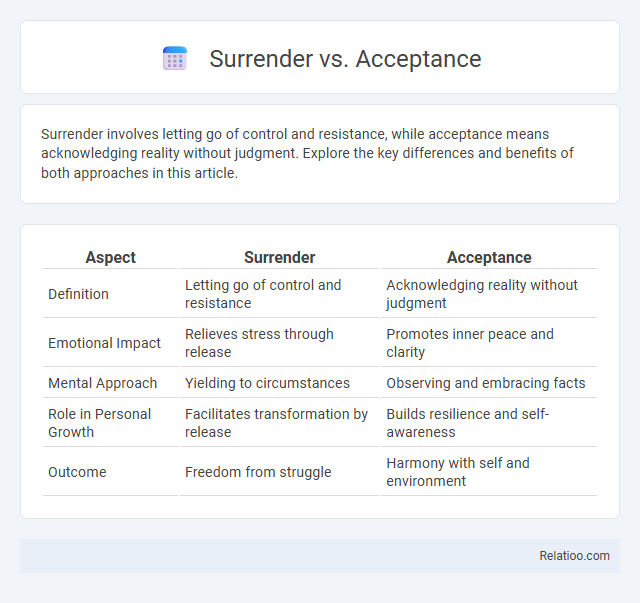Surrender involves letting go of control and resistance, while acceptance means acknowledging reality without judgment. Explore the key differences and benefits of both approaches in this article.
Table of Comparison
| Aspect | Surrender | Acceptance |
|---|---|---|
| Definition | Letting go of control and resistance | Acknowledging reality without judgment |
| Emotional Impact | Relieves stress through release | Promotes inner peace and clarity |
| Mental Approach | Yielding to circumstances | Observing and embracing facts |
| Role in Personal Growth | Facilitates transformation by release | Builds resilience and self-awareness |
| Outcome | Freedom from struggle | Harmony with self and environment |
Understanding the Concepts: Surrender vs Acceptance
Surrender involves letting go of resistance and control, often in challenging situations, to achieve peace or resolution. Acceptance means acknowledging reality as it is, without judgment or attempts to change it, which can foster emotional resilience. Understanding the distinction between surrender and acceptance helps you navigate difficult experiences with clarity and inner calm.
Defining Surrender: Letting Go of Control
Surrender involves consciously relinquishing control and embracing uncertainty without resistance, contrasting with acceptance, which acknowledges reality without necessarily releasing control. True surrender requires a deep trust in the process, allowing emotions and outcomes to flow naturally rather than being forcefully managed. This fundamental act of letting go fosters inner peace and creates space for growth beyond habitual control mechanisms.
What Acceptance Really Means
Acceptance involves acknowledging reality without resistance or denial, allowing for emotional clarity and peace. Unlike surrender, which implies giving up control or yielding to an external force, acceptance is an active process of embracing the present moment as it is. This mindset fosters resilience and empowers individuals to respond thoughtfully rather than react impulsively.
Psychological Perspectives on Surrender and Acceptance
Psychological perspectives differentiate surrender as a conscious release of resistance to uncontrollable circumstances, fostering emotional relief and reduced stress, whereas acceptance involves acknowledging reality without judgment, promoting adaptive coping and resilience. Surrender often relates to relinquishing personal control to external forces or higher powers, facilitating emotional surrender that can lead to a transformative healing process. Acceptance serves as a foundational cognitive strategy in therapies like Acceptance and Commitment Therapy (ACT), enabling individuals to embrace thoughts and feelings without avoidance, thereby improving psychological flexibility and well-being.
The Key Differences Between Surrender and Acceptance
Surrender involves relinquishing control and yielding to a situation, often accompanied by a sense of giving up resistance, while acceptance means acknowledging and embracing reality without trying to change it, fostering peace and clarity in your mindset. The key difference lies in surrender's connotation of submission, whereas acceptance reflects conscious acknowledgment and mental calmness. Understanding these distinctions helps you navigate challenges more effectively by choosing whether to release control or fully embrace the present moment.
Emotional Impact: How Surrender and Acceptance Affect Well-being
Surrender involves yielding control and releasing resistance, often leading to reduced stress and emotional relief by letting go of struggles. Acceptance entails acknowledging reality without judgment, promoting psychological well-being through increased resilience and emotional balance. Both surrender and acceptance contribute to improved mental health by fostering calmness, reducing anxiety, and enhancing overall emotional harmony.
The Role of Mindfulness in Acceptance and Surrender
Mindfulness plays a crucial role in both acceptance and surrender by fostering present-moment awareness and reducing resistance to experiences. In acceptance, mindfulness encourages observing thoughts and emotions without judgment, allowing individuals to acknowledge reality without avoidance. During surrender, mindfulness deepens the release of control, enabling a conscious letting go and embracing of uncertainty with calmness and clarity.
Common Misconceptions About Surrender and Acceptance
Common misconceptions about surrender and acceptance often confuse surrender with giving up or weakness, whereas surrender involves conscious letting go of resistance to gain inner peace and clarity. Acceptance is frequently misunderstood as passive resignation, but it is an active acknowledgment of reality without denial or avoidance. Both surrender and acceptance require strength and awareness, differing fundamentally from defeat, and are key components in emotional resilience and stress reduction.
Practical Steps to Practice Acceptance Over Surrender
Practicing acceptance over surrender involves recognizing reality without resistance and consciously choosing to engage with present circumstances rather than relinquishing control entirely. Practical steps include mindful awareness of emotions, reframing challenges as opportunities for growth, and setting realistic intentions to adapt while maintaining agency. This approach fosters resilience by combining acknowledgment of limitations with proactive problem-solving and emotional regulation.
Choosing the Right Path: When to Surrender and When to Accept
Choosing the right path between surrender and acceptance hinges on recognizing control and letting go of resistance. Surrender involves releasing control over situations beyond one's power, fostering peace through relinquishment, while acceptance means acknowledging reality as it is without judgment, enabling emotional resilience. Understanding when to surrender versus accept promotes mental clarity and growth by balancing action with inner calm.

Infographic: Surrender vs Acceptance
 relatioo.com
relatioo.com